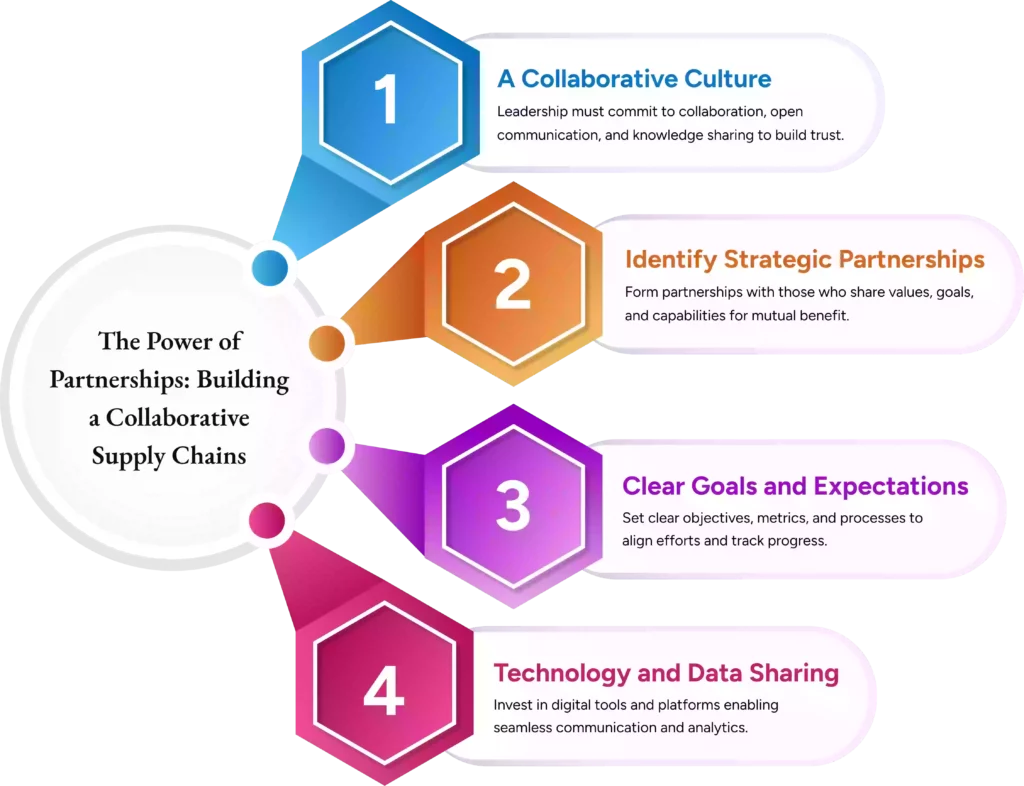In the fast-paced interconnected world of supply chain, collaboration has emerged as a powerful tool for driving transformation and achieving breakthroughs, much like Toyota supply chain strategy has demonstrated.
Companies that embrace collaborative partnerships are reaping the rewards of reduced costs, improved efficiency, and enhanced resilience. Collaborative partnerships are not a new concept in the business world, but their importance has grown exponentially in recent years.
Companies are realizing that they can no longer operate in isolation; instead, they must work closely with their suppliers, customers, and other stakeholders to create agile and efficient supply chains that can withstand the challenges of the 21st century.

The Power Of Collaborative Supply Chain
Collaborative supply chain models have become essential for businesses seeking to navigate the complexities of modern supply chains effectively.
These models enable companies to work together, share resources and knowledge, and leverage collective bargaining power to negotiate better pricing terms with suppliers.
By fostering collaboration, companies can achieve greater efficiency, cost savings, and improved quality and speed in their supply chain operation.
Enhanced Visibility and Transparency
One of the key benefits of collaborative partnerships is enhanced visibility and transparency throughout the supply chain.
When companies collaborate closely with their suppliers and customers, they gain access to real time data and insights that allow them to better understand the flow of the goods and information.
This visibility enables more accurate demand forecasting improved inventory management, and quicker response to disruptions.
Faster Innovation leading to Supply Chain Optimization
Innovation is significant for staying competitive in today’s fast-paced business environment. Collaborative partnerships facilitate the exchange of the ideas and expertise between partners, fostering the culture of innovation.
Suppliers, customers, and other stakeholders can collaborate on product development, process improvement, and sustainability initiatives, driving transformational change within the supply chain.
Understanding the Essence of Supply Chain Purchasing Cooperatives
One of the most prominent examples of a collaborative supply chain model is the supply chain purchasing cooperative.
These cooperatives bring together a group of companies that pool their resources and purchasing power to achieve value through negotiated pricing and terms with preferred suppliers.
By joining forces, companies can streamline procurement processes, manage categories of spend more effectively, and optimize their supply chain optimization and management.
Building Collaborative Relationships for Success
To harness the full potential of collaborative supply chain models and purchasing cooperatives, businesses must proactively build and nurture collaborative relationships. Here are some key strategies to foster successful collaborations.
Foster a Collaborative Culture
Creating a collaborative culture starts with leadership commitment and a shared vision. Leaders should emphasize the importance of collaboration, encourage open communication, and create a safe space for sharing ideas and insights.
By fostering a collaborative culture, businesses can inspire trust, encourage knowledge sharing, and drive cross-functional collaboration.
Identify Strategic Partnerships for Supply Chain Optimization
When forming collaborative partnerships, businesses should carefully identify partners who share similar values, goals, and capabilities.
Strategic partnerships should be based on mutual trust, aligned objectives, and clear understandings of each partner’s contribution to the collaboration.
This ensures that the collaboration is built on a solid foundation and has a higher likelihood of success.
Establish Clear Goals and Expectations
Collaborative partnerships should have clear goals, expectations, and performance metrics. By setting clear objectives, businesses can align their efforts, track progress, and measure the impact of the collaboration.
Regular communication and feedback are essential to ensure that all partners are working towards the same goals and to address any challenges or issues that may arise.
Embrace Technology and Data Sharing
Technology plays a crucial role in facilitating collaboration and data sharing across the supply chain. Businesses should invest in digital tools, platforms, and systems that enable seamless communication, real-time information sharing, and data analytics.
Leveraging technology allows partners to collaborate more effectively, make data-driven decisions, and identify opportunities for optimization and improvement.
More Success Studies
Toyota Supply Chain and Its Suppliers Network
Toyota is renowned for its collaborative approach to supply chain management. The company works closely with its suppliers to ensure a seamless flow of parts and materials.
This collaboration has led to just-in-time inventory practices, reduced waste, and improved product quality.
Unilever’s Sustainable Living Plan
Unilever, a consumer good(s) giant, has partnered with various stakeholders to promote sustainability across its supply chain.
The company’s Sustainable Living Plan aims to reduce its environmental footprint and enhance social impact. Unilever collaborates with suppliers, NGOs, and governments to achieve these ambitious goals.
Zara’s Fast Fashion Model
Zara, a fashion retailer, is known for its agile supply chain that responds quickly to consumer trends.
The company collaborates closely with its suppliers and uses a vertically integrated model to shorten lead times and deliver new products to stores rapidly.
The Next Change with Supply Chain Optimization
Collaborative partnerships are no longer optional but essential for companies looking to thrive in the modern business landscape.
By working closely with suppliers, customers, and other stakeholders, companies can enhance visibility, improve efficiency, foster innovation, mitigate risks, and promote sustainability across the supply chain.
These partnerships are not just about driving incremental improvements; they have the potential to bring about transformational change that can reshape industries and drive long-term success.
Embracing collaborative partnerships is the key to a resilient and agile supply chain in the 21st century.



